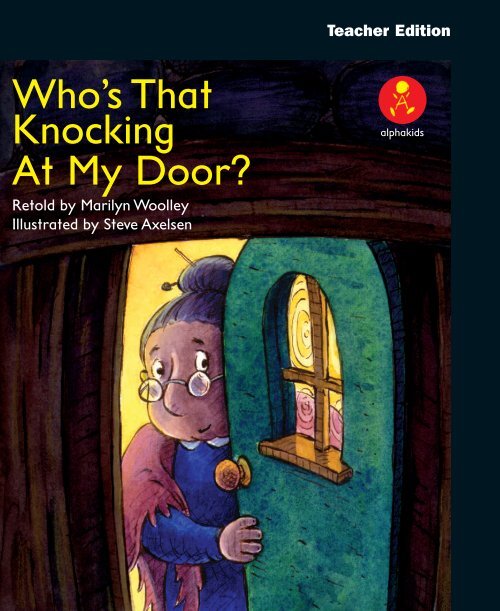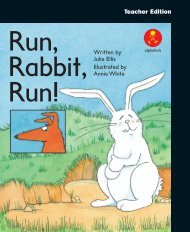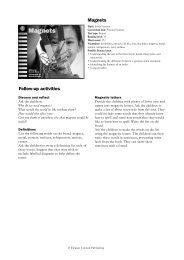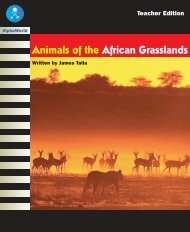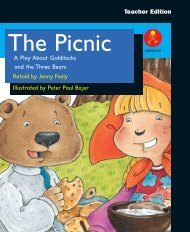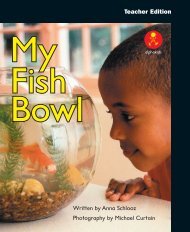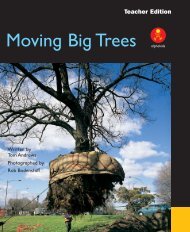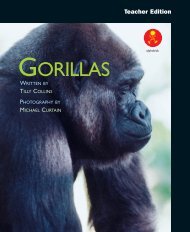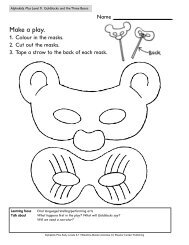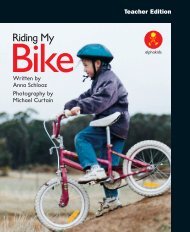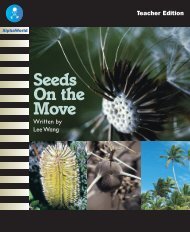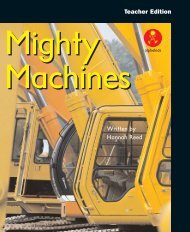Who's That Knocking At My Door?
Who's That Knocking At My Door?
Who's That Knocking At My Door?
Create successful ePaper yourself
Turn your PDF publications into a flip-book with our unique Google optimized e-Paper software.
Teacher Edition<br />
Who’s <strong>That</strong><br />
<strong>Knocking</strong><br />
<strong>At</strong> <strong>My</strong> <strong>Door</strong>?<br />
Retold by Marilyn Woolley<br />
Illustrated by Steve Axelsen<br />
alphakids
Published edition<br />
© Eleanor Curtain<br />
Publishing 2004<br />
First published 2004<br />
Apart from any fair dealing for<br />
the purposes of study, research,<br />
criticism or review, as<br />
permitted under the Copyright<br />
Act of Australia, no part of this<br />
book may be reproduced by<br />
any process, or transmitted in<br />
any form, without permission<br />
of the copyright owner. Where<br />
copies of part or the whole of<br />
this book are made under Part<br />
VB of the Copyright Act, the<br />
law requires that records of<br />
such copying be kept and the<br />
copyright owner is entitled to<br />
claim payment.<br />
Developed by<br />
Eleanor Curtain Publishing<br />
Text: Nicole di Marco<br />
Consultant: Susan Hill<br />
Designed by<br />
Alexander Stitt<br />
Production by<br />
Publishing Solutions<br />
Printed in China<br />
ISBN 0 7253 3408 8<br />
1 2 3 4 5 6 7 8 9<br />
04 05 06<br />
?<br />
How to use this book<br />
Before reading: Talkthrough<br />
Talk through the book with the children. Encourage<br />
them to predict the text from the cover and the<br />
pictures, and to think about the information they<br />
provide. Direct the children’s attention to aspects of<br />
the text that may challenge them. Support the children<br />
to deal with these challenges by asking the<br />
Talkthrough questions on each page.<br />
During reading: Observe and support<br />
Observe the children as they read. Encourage them to<br />
monitor their own reading as they comprehend the<br />
text. As needed, support the children by helping them<br />
to discover and use reading strategies and cues to solve<br />
problems and respond to reading challenges that arise<br />
in the text. Interruptions to the children’s reading<br />
should be minimal and focused on specified learning<br />
needs.<br />
After reading: Comprehension, returning to<br />
the text, responding and writing links<br />
To further develop children’s understanding of the<br />
text, select from activities found on page 16 and the<br />
inside back cover. These whole text, sentence and word<br />
level activities reinforce the teaching focus of this<br />
book. Assessment ideas are provided to assist with<br />
planning for further teaching.<br />
Text highlights<br />
• The text is both cumulative and repetitive.<br />
• Colour illustrations support and extend<br />
the text.<br />
Vocabulary<br />
funny, hopped, knocking, popped, short,<br />
someone, spun, stood, waited, wide
Setting the context<br />
Who knocks on your door at home? What<br />
happens when they do?<br />
Introducing the book<br />
This book is about someone knocking at an<br />
old woman’s door.<br />
Front cover<br />
Who has opened the door?<br />
Who might have knocked at the old<br />
woman’s door?<br />
What do you think she will do?<br />
Title page<br />
Read the title of the book together.<br />
Point out the names of the author and<br />
illustrator.
Who’s <strong>That</strong> <strong>Knocking</strong> <strong>At</strong> <strong>My</strong> <strong>Door</strong> Pages 2–3<br />
?<br />
Talkthrough<br />
This old woman lives by herself in a big old house. What is the<br />
old woman doing? What is she waiting for?<br />
Observe and support<br />
Do the children use contextual information to<br />
understand the meaning of new vocabulary?<br />
What does ‘spun’ mean? How did you work that out?<br />
2
Who’s <strong>That</strong> <strong>Knocking</strong> <strong>At</strong> <strong>My</strong> <strong>Door</strong> Pages 4–5<br />
?<br />
Talkthrough<br />
One day there was a knock at the old woman’s door. What has<br />
come to her door? What do the two big, big feet do? What does<br />
the old woman say?<br />
Observe and support<br />
Can the children explain the purpose of exclamation<br />
marks? Point to the exclamation marks.<br />
What are these called? What are they used for?<br />
4
Who’s <strong>That</strong> <strong>Knocking</strong> <strong>At</strong> <strong>My</strong> <strong>Door</strong> Pages 6–7<br />
?<br />
Talkthrough<br />
Soon there was another knock at the old woman’s door. What<br />
comes in next? What do the thin, thin legs do? What does the<br />
old woman say this time?<br />
Observe and support<br />
Do the children pay attention to the punctuation and<br />
other textual information to support expressive<br />
reading?<br />
How do we read words ending with an exclamation mark? Why<br />
are the words ‘Knock! Knock! <strong>Knocking</strong>!’ in red? How would your<br />
voice sound when you read these words?<br />
6
Who’s <strong>That</strong> <strong>Knocking</strong> <strong>At</strong> <strong>My</strong> <strong>Door</strong> Pages 8–9<br />
?<br />
Talkthrough<br />
A wide, wide body came in the old woman’s door. What does<br />
‘wide’ mean? Show me a wide, wide shape with your arms.<br />
What will the wide, wide body do?<br />
Observe and support<br />
Do the children use an understanding of letter-sound<br />
relationships to check words?<br />
You read, ‘In came a wide, wide body’. How did you know that<br />
word was ‘wide’? What did you look at? What did you think<br />
about?<br />
8
Who’s <strong>That</strong> <strong>Knocking</strong> <strong>At</strong> <strong>My</strong> <strong>Door</strong> Pages 10–11<br />
?<br />
Talkthrough<br />
Two short, short arms knocked at the old woman’s door. How do<br />
they attach themselves to the wide, wide body? What will the<br />
old woman say? How do you know?<br />
Observe and support<br />
Do the children notice if they have made a mistake?<br />
Do they re-read to the point of difficulty?<br />
What did you notice? What might fit there? What would make<br />
sense?<br />
10
Who’s <strong>That</strong> <strong>Knocking</strong> <strong>At</strong> <strong>My</strong> <strong>Door</strong> Pages 12–13<br />
?<br />
Talkthrough<br />
What do the short, short arms need? What sort of hands come<br />
in? How will the old woman react?<br />
Observe and support<br />
Can the children understand the literal meaning of the<br />
text?<br />
How do the fat, fat hands attach themselves to the short, short<br />
arms? Where did you find that out?<br />
12
Who’s <strong>That</strong> <strong>Knocking</strong> <strong>At</strong> <strong>My</strong> <strong>Door</strong> Pages 14–15<br />
?<br />
Talkthrough<br />
What do you think will happen next? Why do you think so?<br />
How will the story end?<br />
Observe and support<br />
Do the children check a range of information on the<br />
page to assist with problem solving?<br />
I noticed that you looked at the picture as you were working<br />
that out. What did you notice that helped you to work out that<br />
sentence?<br />
14
Who’s <strong>That</strong> <strong>Knocking</strong> <strong>At</strong> <strong>My</strong> <strong>Door</strong> Page 16<br />
? Talkthrough<br />
Who is the old woman’s visitor? What does the old woman say?<br />
Is the ending what you expected?<br />
Does this book remind you of any others you have read? In<br />
what ways?<br />
16<br />
After reading<br />
Being a meaning maker<br />
Encourage the children to support their responses<br />
with evidence from the book as they discuss these<br />
comprehension questions:<br />
What was the old woman waiting for?<br />
What came into the old woman’s house first?<br />
What came in next? And then?<br />
How did the old woman feel about her visitor?<br />
Was the old woman’s visitor really funny?
Being a code breaker<br />
Explore the following language features:<br />
• High-frequency words: an, by, in, a,<br />
big, she, in, her, and, she, for, to,<br />
come, one, there, was, at, in, said,<br />
the, came, two, they, on, how, soon,<br />
those, went, up, you, are, so.<br />
• Punctuation: explore the use of<br />
capital letters, full stops, commas,<br />
quotation marks and exclamation<br />
marks.<br />
Being a text user<br />
Refer to the text when discussing these<br />
questions:<br />
What information is contained in the writing?<br />
What information is contained in the<br />
illustrations?<br />
Being a text critic<br />
The author has written the story so that one<br />
part of the clown arrives at the old woman’s<br />
house at a time. How does this help make the<br />
story interesting?<br />
Would the story be as good if the clown<br />
arrived in one piece?<br />
Responding to text<br />
Encourage the children to work in<br />
cooperative groups to make stick<br />
puppets of the old woman and the<br />
different parts of the clown. These could<br />
be used to retell the story as a play. Ask<br />
the children to add sound effects; for<br />
example, the knocking at the door.<br />
Have the children work in groups<br />
to write sentences describing what<br />
the different parts of the clown’s body do.<br />
For example, ‘The fat, fat hands popped<br />
onto the short, short arms’.<br />
Ask the children to go through this<br />
book and other familiar texts and<br />
make a list of adjectives; for example, big,<br />
thin, wide.<br />
Writing<br />
The children could work in pairs to<br />
create their own character who arrives at<br />
a door in pieces. The children could use<br />
the list of adjectives to assist them.<br />
Working in the same pairs, ask the<br />
children to write their own story in which<br />
the character they created arrives at<br />
someone’s door.<br />
Assessment<br />
Can the children:<br />
• predict what will come next based on the cumulative nature of the text?<br />
• explain what an exclamation mark is and why it has been used?<br />
whole text activity sentence activity word activity
alphakids<br />
Who’s <strong>That</strong><br />
<strong>Knocking</strong><br />
<strong>At</strong> <strong>My</strong> <strong>Door</strong>?<br />
Retold by Marilyn Woolley<br />
Illustrated by Steve Axelsen<br />
Teacher<br />
Edition<br />
Other<br />
books<br />
at this<br />
level<br />
<strong>My</strong><br />
Trip<br />
Written by<br />
Mary-Anne Creasy<br />
alphakids<br />
Photography by<br />
Michael Curtain<br />
Topic: Traditional tales<br />
Curriculum link: English<br />
Text type: Narrative<br />
Reading level: 10<br />
Word count: 326<br />
High-frequency words: a, an, and, are, at, big, by,<br />
came, come, for, her, how, in, on, one, said, she, so,<br />
soon, the, there, they, those, to, two, up, was, went,<br />
you<br />
Vocabulary: funny, hopped, knocking, popped,<br />
short, someone, spun, stood, waited, wide<br />
Baby Bear<br />
Goes Goes Visiting for a Walk<br />
Retold by Jenny Feely<br />
alphakids<br />
Illustrated by Peter Paul Bajer<br />
Reptiles<br />
alphakids<br />
Sebastian’s<br />
New Sister<br />
Written by<br />
Mary-Anne Creasy<br />
Illustrated by<br />
Alex Stitt<br />
Spiders<br />
alphakids<br />
alphakids<br />
Possible literacy focus<br />
Retelling a cumulative text.<br />
Using exclamation marks in writing.<br />
Written by Sarah O’Neil<br />
Written by Hannah Reed<br />
Summary<br />
This book is a narrative written in the style of a<br />
traditional story. It tells the tale of an old woman<br />
who hears someone knocking at her door. Each time<br />
she answers the door, another part of a clown arrives<br />
until he is whole.<br />
Photography by Patrick Honan<br />
ISBN 0- 7253- 3408- 8<br />
9 780725 334086<br />
alphakids


